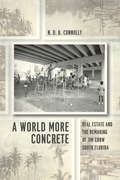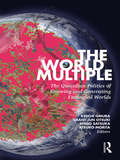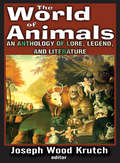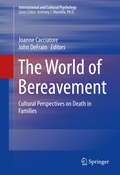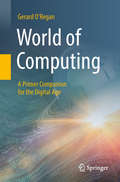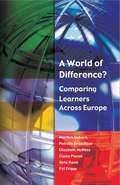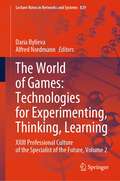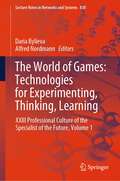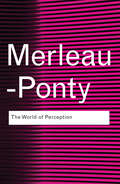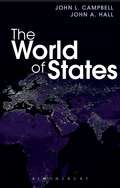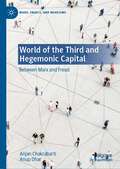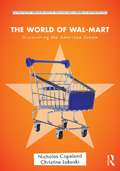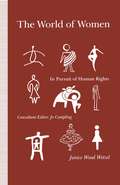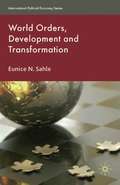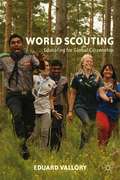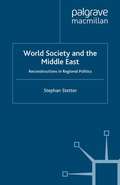- Table View
- List View
A World More Concrete: Real Estate and the Remaking of Jim Crow South Florida (Historical Studies of Urban America)
by N. D. ConnollyMany people characterize urban renewal projects and the power of eminent domain as two of the most widely despised and often racist tools for reshaping American cities in the postwar period. In A World More Concrete, N. D. B. Connolly uses the history of South Florida to unearth an older and far more complex story. Connolly captures nearly eighty years of political and land transactions to reveal how real estate and redevelopment created and preserved metropolitan growth and racial peace under white supremacy. Using a materialist approach, he offers a long view of capitalism and the color line, following much of the money that made land taking and Jim Crow segregation profitable and preferred approaches to governing cities throughout the twentieth century. A World More Concrete argues that black and white landlords, entrepreneurs, and even liberal community leaders used tenements and repeated land dispossession to take advantage of the poor and generate remarkable wealth. Through a political culture built on real estate, South Florida’s landlords and homeowners advanced property rights and white property rights, especially, at the expense of more inclusive visions of equality. For black people and many of their white allies, uses of eminent domain helped to harden class and color lines. Yet, for many reformers, confiscating certain kinds of real estate through eminent domain also promised to help improve housing conditions, to undermine the neighborhood influence of powerful slumlords, and to open new opportunities for suburban life for black Floridians. Concerned more with winners and losers than with heroes and villains, A World More Concrete offers a sober assessment of money and power in Jim Crow America. It shows how negotiations between powerful real estate interests on both sides of the color line gave racial segregation a remarkable capacity to evolve, revealing property owners’ power to reshape American cities in ways that can still be seen and felt today.
A World More Concrete: Real Estate and the Remaking of Jim Crow South Florida (Historical Studies of Urban America)
by N. D. ConnollyMany people characterize urban renewal projects and the power of eminent domain as two of the most widely despised and often racist tools for reshaping American cities in the postwar period. In A World More Concrete, N. D. B. Connolly uses the history of South Florida to unearth an older and far more complex story. Connolly captures nearly eighty years of political and land transactions to reveal how real estate and redevelopment created and preserved metropolitan growth and racial peace under white supremacy. Using a materialist approach, he offers a long view of capitalism and the color line, following much of the money that made land taking and Jim Crow segregation profitable and preferred approaches to governing cities throughout the twentieth century. A World More Concrete argues that black and white landlords, entrepreneurs, and even liberal community leaders used tenements and repeated land dispossession to take advantage of the poor and generate remarkable wealth. Through a political culture built on real estate, South Florida’s landlords and homeowners advanced property rights and white property rights, especially, at the expense of more inclusive visions of equality. For black people and many of their white allies, uses of eminent domain helped to harden class and color lines. Yet, for many reformers, confiscating certain kinds of real estate through eminent domain also promised to help improve housing conditions, to undermine the neighborhood influence of powerful slumlords, and to open new opportunities for suburban life for black Floridians. Concerned more with winners and losers than with heroes and villains, A World More Concrete offers a sober assessment of money and power in Jim Crow America. It shows how negotiations between powerful real estate interests on both sides of the color line gave racial segregation a remarkable capacity to evolve, revealing property owners’ power to reshape American cities in ways that can still be seen and felt today.
A World More Concrete: Real Estate and the Remaking of Jim Crow South Florida (Historical Studies of Urban America)
by N. D. ConnollyMany people characterize urban renewal projects and the power of eminent domain as two of the most widely despised and often racist tools for reshaping American cities in the postwar period. In A World More Concrete, N. D. B. Connolly uses the history of South Florida to unearth an older and far more complex story. Connolly captures nearly eighty years of political and land transactions to reveal how real estate and redevelopment created and preserved metropolitan growth and racial peace under white supremacy. Using a materialist approach, he offers a long view of capitalism and the color line, following much of the money that made land taking and Jim Crow segregation profitable and preferred approaches to governing cities throughout the twentieth century. A World More Concrete argues that black and white landlords, entrepreneurs, and even liberal community leaders used tenements and repeated land dispossession to take advantage of the poor and generate remarkable wealth. Through a political culture built on real estate, South Florida’s landlords and homeowners advanced property rights and white property rights, especially, at the expense of more inclusive visions of equality. For black people and many of their white allies, uses of eminent domain helped to harden class and color lines. Yet, for many reformers, confiscating certain kinds of real estate through eminent domain also promised to help improve housing conditions, to undermine the neighborhood influence of powerful slumlords, and to open new opportunities for suburban life for black Floridians. Concerned more with winners and losers than with heroes and villains, A World More Concrete offers a sober assessment of money and power in Jim Crow America. It shows how negotiations between powerful real estate interests on both sides of the color line gave racial segregation a remarkable capacity to evolve, revealing property owners’ power to reshape American cities in ways that can still be seen and felt today.
A World More Concrete: Real Estate and the Remaking of Jim Crow South Florida (Historical Studies of Urban America)
by N. D. ConnollyMany people characterize urban renewal projects and the power of eminent domain as two of the most widely despised and often racist tools for reshaping American cities in the postwar period. In A World More Concrete, N. D. B. Connolly uses the history of South Florida to unearth an older and far more complex story. Connolly captures nearly eighty years of political and land transactions to reveal how real estate and redevelopment created and preserved metropolitan growth and racial peace under white supremacy. Using a materialist approach, he offers a long view of capitalism and the color line, following much of the money that made land taking and Jim Crow segregation profitable and preferred approaches to governing cities throughout the twentieth century. A World More Concrete argues that black and white landlords, entrepreneurs, and even liberal community leaders used tenements and repeated land dispossession to take advantage of the poor and generate remarkable wealth. Through a political culture built on real estate, South Florida’s landlords and homeowners advanced property rights and white property rights, especially, at the expense of more inclusive visions of equality. For black people and many of their white allies, uses of eminent domain helped to harden class and color lines. Yet, for many reformers, confiscating certain kinds of real estate through eminent domain also promised to help improve housing conditions, to undermine the neighborhood influence of powerful slumlords, and to open new opportunities for suburban life for black Floridians. Concerned more with winners and losers than with heroes and villains, A World More Concrete offers a sober assessment of money and power in Jim Crow America. It shows how negotiations between powerful real estate interests on both sides of the color line gave racial segregation a remarkable capacity to evolve, revealing property owners’ power to reshape American cities in ways that can still be seen and felt today.
A World More Concrete: Real Estate and the Remaking of Jim Crow South Florida (Historical Studies of Urban America)
by N. D. ConnollyMany people characterize urban renewal projects and the power of eminent domain as two of the most widely despised and often racist tools for reshaping American cities in the postwar period. In A World More Concrete, N. D. B. Connolly uses the history of South Florida to unearth an older and far more complex story. Connolly captures nearly eighty years of political and land transactions to reveal how real estate and redevelopment created and preserved metropolitan growth and racial peace under white supremacy. Using a materialist approach, he offers a long view of capitalism and the color line, following much of the money that made land taking and Jim Crow segregation profitable and preferred approaches to governing cities throughout the twentieth century. A World More Concrete argues that black and white landlords, entrepreneurs, and even liberal community leaders used tenements and repeated land dispossession to take advantage of the poor and generate remarkable wealth. Through a political culture built on real estate, South Florida’s landlords and homeowners advanced property rights and white property rights, especially, at the expense of more inclusive visions of equality. For black people and many of their white allies, uses of eminent domain helped to harden class and color lines. Yet, for many reformers, confiscating certain kinds of real estate through eminent domain also promised to help improve housing conditions, to undermine the neighborhood influence of powerful slumlords, and to open new opportunities for suburban life for black Floridians. Concerned more with winners and losers than with heroes and villains, A World More Concrete offers a sober assessment of money and power in Jim Crow America. It shows how negotiations between powerful real estate interests on both sides of the color line gave racial segregation a remarkable capacity to evolve, revealing property owners’ power to reshape American cities in ways that can still be seen and felt today.
The World Multiple: The Quotidian Politics of Knowing and Generating Entangled Worlds (Routledge Advances in Sociology)
by Keiichi Omura Grant Jun Otsuki Shiho Satsuka Atsuro MoritaThe World Multiple, as a collection, is an ambitious ethnographic experiment in understanding how the world is experienced and generated in multiple ways through people’s everyday practices. Against the dominant assumption that the world is a single universal reality that can only be known by modern expert science, this book argues that worlds are worlded—they are socially and materially crafted in multiple forms in everyday practices involving humans, landscapes, animals, plants, fungi, rocks, and other beings. These practices do not converge to a singular knowledge of the world, but generate a world multiple—a world that is more than one integrated whole, yet less than many fragmented parts. The book brings together authors from Europe, Japan, and North America, in conversation with ethnographic material from Africa, the Americas, and Asia, in order to explore the possibilities of the world multiple to reveal new ways to intervene in the legacies of colonialism, imperialism, and capitalism that inflict damage on humans and nonhumans. The contributors show how the world is formed through interactions among techno-scientific, vernacular, local, and indigenous practices, and examine the new forms of politics that emerge out of them. Engaged with recent anthropological discussions of ontologies, the Anthropocene, and multi-species ethnography, the book addresses the multidimensional realities of people’s lives and the quotidian politics they entail.
The World Multiple: The Quotidian Politics of Knowing and Generating Entangled Worlds (Routledge Advances in Sociology)
by Keiichi Omura Shiho Satsuka Atsuro Morita Grant Jun OtsukiThe World Multiple, as a collection, is an ambitious ethnographic experiment in understanding how the world is experienced and generated in multiple ways through people’s everyday practices. Against the dominant assumption that the world is a single universal reality that can only be known by modern expert science, this book argues that worlds are worlded—they are socially and materially crafted in multiple forms in everyday practices involving humans, landscapes, animals, plants, fungi, rocks, and other beings. These practices do not converge to a singular knowledge of the world, but generate a world multiple—a world that is more than one integrated whole, yet less than many fragmented parts. The book brings together authors from Europe, Japan, and North America, in conversation with ethnographic material from Africa, the Americas, and Asia, in order to explore the possibilities of the world multiple to reveal new ways to intervene in the legacies of colonialism, imperialism, and capitalism that inflict damage on humans and nonhumans. The contributors show how the world is formed through interactions among techno-scientific, vernacular, local, and indigenous practices, and examine the new forms of politics that emerge out of them. Engaged with recent anthropological discussions of ontologies, the Anthropocene, and multi-species ethnography, the book addresses the multidimensional realities of people’s lives and the quotidian politics they entail.
The World of Animals: An Anthology of Lore, Legend, and Literature
by Joseph KrutchHuman beings share the earth with many other living creatures and have dealt with them in many different ways. Animals have furnished humans with food, done their work, aroused their curiosity, provided them with "sport," stimulated their sense of beauty, and provoked their wonder. They have also shared affection, when both the human and animal have decided to give it. No less varied or avoidable are the attitudes humans have developed toward these creatures.This collection of writings selected from a vast literature about animals is also about the people who have been inspired to write on that subject. Sometimes consciously and sometimes unconsciously the writer implies an answer to one or more of the questions that any concern with an animal must raise, such as: What is an animal's place in nature? Are they here primarily to serve as a food source? Do they possess inherent rights and privileges? How are they alike or different from humans? The answers to these questions are as varied as the authors. Each narrative description, or exposition contributes something to an over-all picture of human beings' relations with and attitudes toward the animal kingdom.It is a remarkable conclusion, illustrated by Krutch's chronological arrangement within categories, that almost every major attitude and activity that has ever existed concerning animals still exists today even though there has been a drift in certain directions. Although the editor fairly represents the opposing view, his sympathies lie with those for whom the animal world embodies something to be loved and learned from rather than merely to be studied or exploited.
The World of Animals: An Anthology of Lore, Legend, and Literature
by Joseph Wood KrutchHuman beings share the earth with many other living creatures and have dealt with them in many different ways. Animals have furnished humans with food, done their work, aroused their curiosity, provided them with "sport," stimulated their sense of beauty, and provoked their wonder. They have also shared affection, when both the human and animal have decided to give it. No less varied or avoidable are the attitudes humans have developed toward these creatures.This collection of writings selected from a vast literature about animals is also about the people who have been inspired to write on that subject. Sometimes consciously and sometimes unconsciously the writer implies an answer to one or more of the questions that any concern with an animal must raise, such as: What is an animal's place in nature? Are they here primarily to serve as a food source? Do they possess inherent rights and privileges? How are they alike or different from humans? The answers to these questions are as varied as the authors. Each narrative description, or exposition contributes something to an over-all picture of human beings' relations with and attitudes toward the animal kingdom.It is a remarkable conclusion, illustrated by Krutch's chronological arrangement within categories, that almost every major attitude and activity that has ever existed concerning animals still exists today even though there has been a drift in certain directions. Although the editor fairly represents the opposing view, his sympathies lie with those for whom the animal world embodies something to be loved and learned from rather than merely to be studied or exploited.
The World of Bereavement: Cultural Perspectives on Death in Families (International and Cultural Psychology)
by Joanne Cacciatore John DeFrainThis visionary work explores the sensitive balance between the personal and private aspects of grief, the social and cultural variables that unite communities in bereavement, and the universal experience of loss. Its global journey takes readers into the processes of coping, ritual, and belief across established and emerging nations, indigenous cultures, and countries undergoing major upheavals, richly detailed by native scholars and practitioners. In these pages, culture itself is recognized as formed through many lenses, from the ancestral to the experiential. The human capacity to mourn, endure, and make meaning is examined in papers such as: Death, grief, and culture in Kenya: experiential strengths-based research. Death and grief in Korea: the continuum of life and death.To live with death: loss in Romanian culture.The Brazilian ways of living, dying, and grieving.Death and bereavement in Israel: Jewish, Muslim, and Christian perspectives.Completing the circle of life: death and grief among Native Americans.It is always normal to remember: death, grief, and culture in Australia.The World of Bereavement will fascinate and inspire clinicians, providers, and researchers in the field of death studies as well as privately-held professional training programs and the bereavement community in general.
World of Computing: A Primer Companion for the Digital Age
by Gerard O'ReganThis engaging work provides a concise introduction to the exciting world of computing, encompassing the theory, technology, history, and societal impact of computer software and computing devices. Spanning topics from global conflict to home gaming, international business, and human communication, this text reviews the key concepts unpinning the technology which has shaped the modern world.Topics and features: introduces the foundations of computing, the fundamentals of algorithms, and the essential concepts from mathematics and logic used in computer science; presents a concise history of computing, discussing the historical figures who made important contributions, and the machines which formed major milestones; examines the fields of human−computer interaction, and software engineering; provides accessible introductions to the core aspects of programming languages, operating systems, and databases; describes the Internet revolution, the invention of the smartphone, and the rise of social media, as well as the Internet of Things and cryptocurrencies; explores legal and ethical aspects of computing, including issues of hacking and cybercrime, and the nature of online privacy, free speech and censorship; discusses such innovations as distributed systems, service-oriented architecture, software as a service, cloud computing, and embedded systems; includes key learning topics and review questions in every chapter, and a helpful glossary.Offering an enjoyable overview of the fascinating and broad-ranging field of computing, this easy-to-understand primer introduces the general reader to the ideas on which the digital world was built, and the historical developments that helped to form the modern age.
A World of Difference? (UK Higher Education OUP Humanities & Social Sciences Education OUP)
by Marilyn Osborn Patricia Broadfoot Elizabeth Mcness Birte Ravn Claire Planel Pat TriggsThis fascinating volume compares the experience of young learners in England, France and Denmark in order to examine the relationship between national educational cultures, individual biographies and classroom practices in creating the context for learning. It explores how secondary schools in three very different education systems work to develop the aptitudes and attitudes conducive to lifelong learning in conditions of complexity, uncertainty and multiple change. By drawing upon a rich data-set including questionnaires, individual and group interviews and classroom observation, the book gives a voice to young learners in the three countries. Through detailed case studies and quotations it examines their concerns with schooling, with teachers, with motivation and achievement and explores the very different social contexts which influence their engagement with learning.This book will be an essential resource for researchers, practitioners, students and policy-makers and all those committed to understanding the relationship between culture and learning and to improving secondary education.
The World of Games: XXIII Professional Culture of the Specialist of the Future, Volume 2 (Lecture Notes in Networks and Systems #829)
by Daria Bylieva Alfred NordmannThis book reflects the various dimensions of play. It gathers together experience with role-play, tabletop, and online games and develops and assesses tools. It also reflects the human condition in this world of games as it becomes a digital world. We are living in a World of Games where every game is a world through which we learn about the world. A World of Games is fun and engaging, but it also provides deceptive pleasures. What may seem like fun is far from harmless. And then there are the many ways of learning in the mode of play.
The World of Games: XXIII Professional Culture of the Specialist of the Future, Volume 1 (Lecture Notes in Networks and Systems #830)
by Daria Bylieva Alfred NordmannThis book reflects the various dimensions of play. It gathers together experience with role-play, tabletop, and online games and develops and assesses tools. It also reflects the human condition in this world of games as it becomes a digital world. We are living in a World of Games where every game is a world through which we learn about the world. A World of Games is fun and engaging, but it also provides deceptive pleasures. What may seem like fun is far from harmless. And then there are the many ways of learning in the mode of play.
The World of Perception
by Maurice Merleau-Ponty'In simple prose Merleau-Ponty touches on his principle themes. He speaks about the body and the world, the coexistence of space and things, the unfortunate optimism of science – and also the insidious stickiness of honey, and the mystery of anger.' - James ElkinsMaurice Merleau-Ponty was one of the most important thinkers of the post-war era. Central to his thought was the idea that human understanding comes from our bodily experience of the world that we perceive: a deceptively simple argument, perhaps, but one that he felt had to be made in the wake of attacks from contemporary science and the philosophy of Descartes on the reliability of human perception.From this starting point, Merleau-Ponty presented these seven lectures on The World of Perception to French radio listeners in 1948. Available in a paperback English translation for the first time in the Routledge Classics series to mark the centenary of Merleau-Ponty’s birth, this is a dazzling and accessible guide to a whole universe of experience, from the pursuit of scientific knowledge, through the psychic life of animals to the glories of the art of Paul Cézanne.
The World of Perception
by Maurice Merleau-Ponty'In simple prose Merleau-Ponty touches on his principle themes. He speaks about the body and the world, the coexistence of space and things, the unfortunate optimism of science – and also the insidious stickiness of honey, and the mystery of anger.' - James ElkinsMaurice Merleau-Ponty was one of the most important thinkers of the post-war era. Central to his thought was the idea that human understanding comes from our bodily experience of the world that we perceive: a deceptively simple argument, perhaps, but one that he felt had to be made in the wake of attacks from contemporary science and the philosophy of Descartes on the reliability of human perception.From this starting point, Merleau-Ponty presented these seven lectures on The World of Perception to French radio listeners in 1948. Available in a paperback English translation for the first time in the Routledge Classics series to mark the centenary of Merleau-Ponty’s birth, this is a dazzling and accessible guide to a whole universe of experience, from the pursuit of scientific knowledge, through the psychic life of animals to the glories of the art of Paul Cézanne.
The World of States
by John L. Campbell John A. HallFor many years, attention in both public and intellectual fields was concentrated on the benefits of civil society. However, with the demand for greater state regulation of the economy and the increasing realisation that states of the fourth world will never advance without the enforcement of a rule of law, the tenor of debate is now changing. This topical book offers a historical account of state forms in the 21st century. It focuses on what makes states effective, thus offering a different approach to existing literature which has tended to focus on the predatory characteristics of states. The book covers all the major state forms of this century, from the US and EU to India and China, as well as a number of key 'failed' states, such as Iraq and Zimbabwe. Key definitions and terms are clearly explained thoroughout. Written leading figures in the field, and addressing one of the key questions in politics today, this is a much-needed addition to the literature.
The World of States
by John L. Campbell John A. HallFor many years, attention in both public and intellectual fields was concentrated on the benefits of civil society. However, with the demand for greater state regulation of the economy and the increasing realisation that states of the fourth world will never advance without the enforcement of a rule of law, the tenor of debate is now changing. This topical book offers a historical account of state forms in the 21st century. It focuses on what makes states effective, thus offering a different approach to existing literature which has tended to focus on the predatory characteristics of states. The book covers all the major state forms of this century, from the US and EU to India and China, as well as a number of key 'failed' states, such as Iraq and Zimbabwe. Key definitions and terms are clearly explained thoroughout. Written leading figures in the field, and addressing one of the key questions in politics today, this is a much-needed addition to the literature.
World of the Third and Hegemonic Capital: Between Marx and Freud (Marx, Engels, and Marxisms)
by Anjan Chakrabarti Anup DharThis book brings together Marxian philosophy and Lacanian psychoanalysis to argue that the hegemonic form of global capital is founded on the foreclosure of class and world of the third. The authors counterpose the world of the third to the mainstream notion of the third world, seen as a lacking other in desperate need of aid and development. Thus, for them, the hegemonic form of global capital is engendered through the foregrounding of the poor, victim third world and the foreclosure of the non-capitalist world of the third. Building on what they characterize as an ab-original reading of Marxian historical materialism and the Lacanian real, the authors seek to conceptualize a counter-hegemonic revolutionary subject as a basis for postcapitalist alternatives to the hegemonic form of global capital.
The World of Wal-Mart: Discounting the American Dream
by Nick Copeland Christine LabuskiThis book demonstrates the usefulness of anthropological concepts by taking a critical look at Wal-Mart and the American Dream. Rather than singling Wal-Mart out for criticism, the authors treat it as a product of a socio-political order that it also helps to shape. The book attributes Wal-Mart’s success to the failure of American (and global) society to make the Dream available to everyone. It shows how decades of neoliberal economic policies have exposed contradictions at the heart of the Dream, creating an opening for Wal-Mart. The company’s success has generated a host of negative externalities, however, fueling popular ambivalence and organized opposition. The book also describes the strategies that Wal-Mart uses to maintain legitimacy, fend off unions, enter new markets, and cultivate an aura of benevolence and ordinariness, despite these externalities. It focuses on Wal-Mart’s efforts to forge symbolic and affective inclusion, and their self-promotion as a free market solution to social problems of poverty, inequality, and environmental destruction. Finally, the book contrasts the conceptions of freedom and human rights that underlie Wal-Mart’s business model to the alternative visions of freedom forwarded by their critics.
The World of Wal-Mart: Discounting the American Dream
by Nick Copeland Christine LabuskiThis book demonstrates the usefulness of anthropological concepts by taking a critical look at Wal-Mart and the American Dream. Rather than singling Wal-Mart out for criticism, the authors treat it as a product of a socio-political order that it also helps to shape. The book attributes Wal-Mart’s success to the failure of American (and global) society to make the Dream available to everyone. It shows how decades of neoliberal economic policies have exposed contradictions at the heart of the Dream, creating an opening for Wal-Mart. The company’s success has generated a host of negative externalities, however, fueling popular ambivalence and organized opposition. The book also describes the strategies that Wal-Mart uses to maintain legitimacy, fend off unions, enter new markets, and cultivate an aura of benevolence and ordinariness, despite these externalities. It focuses on Wal-Mart’s efforts to forge symbolic and affective inclusion, and their self-promotion as a free market solution to social problems of poverty, inequality, and environmental destruction. Finally, the book contrasts the conceptions of freedom and human rights that underlie Wal-Mart’s business model to the alternative visions of freedom forwarded by their critics.
The World of Women: In Pursuit of Human Rights
by Janice Wood WetzelThe book is concerned with social issues and problems that effect women throughout the world, the policies and practices that impinge on their human rights, and the programmes around the globe that are successfully changing their conditions. This interdisciplinary work provides a rich resource of information, linking discrimination and violence against women to family law, sex roles to sex industries, and sexual oppression to politics, education, employment, health and mental health.
World Orders, Development and Transformation (International Political Economy Series)
by E. SahleThe book examines how hegemonic development ideas and practices emerged in the context of the changing world order post-1945 and how this transformation was characterized by neoliberalism and securitization of development and security. Sahle also explores the rise of China and the start of Obama's presidency.
World Scouting: Educating for Global Citizenship
by E. ValloryIn a very comprehensible and entertaining way explores the main findings of the first academic research on world scouting, the largest young movement on the planet. The work revisits scouting's origins, analyzing its structure and recognition policy, its role in developing ideas of global citizenship and belonging, and the spirit of scouting.
World Society and the Middle East: Reconstructions in Regional Politics (Rethinking Peace and Conflict Studies)
by S. StetterOffers a novel cross-disciplinary theoretical perspective on conflict and conflict transformation in world society, and integrates the study of conflicts in the Middle East region into a modern systems theoretical framework.
